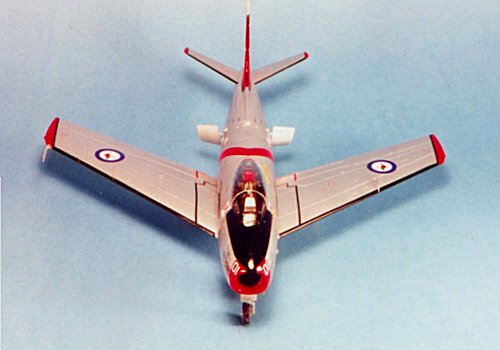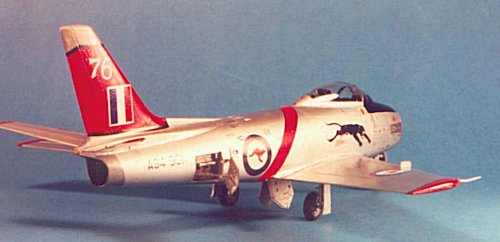
Red Roo/Hasegawa 1/48 RAAF Avon Sabre
|
KIT # |
|
|
PRICE: |
$20 for the conversion set |
|
DECALS: |
See Review |
|
REVIEW & |
|
|
NOTES: |
Conversion for Hasegawa 1/48 F-86 |

|
HISTORY |
Australia's first jet fighter was the DeHavilland Vampire, built under license by Commonwealth Aircraft in 1948-49. The follow-on possibilities included the Grumman Panther and the Hawker P.1081, a project which never went past the prototype. The advent of the Korean War brought the acquisition of the Gloster Meteor F.8 as an interim type. RAAF pilots in Korea soon learned that the Meteor was completely outclassed by the MiG-15, and began a campaign to acquire the North American F-86 Sabre.
The Australian government signed an agreement with North American on February 22, 1951 for license production of the Sabre. For economic reasons, the RAAF had to insure that its equipment would remain effective well into the 1960s. This meant that the RAAF Sabre needed more modern armament than the World War II era six .50 caliber machine guns, and an uprated powerplant for improved performance. The 30mm Aden cannon was chosen for the new armament, and the Rolls-Royce Avon RA-7 engine became the new powerplant, with an increase from the 6,100 lbs of thrust of the G.E. J-47 to 7,500 lbs of thrust with the Avon.
 The change in powerplant
required a redesign of the Sabre's fuselage to cater to the increased airflow
requirement of the Avon, and to the fact that the engine was 500 lbs lighter
than the J-47, requiring that it be re-positioned further aft. The intake was
deepened 3.5 inches, and the fuselage "break" was re-positioned. The
redesign involved changing 60 percent of the original fuselage structure. The
end result was the most formidable Sabre of all.
The change in powerplant
required a redesign of the Sabre's fuselage to cater to the increased airflow
requirement of the Avon, and to the fact that the engine was 500 lbs lighter
than the J-47, requiring that it be re-positioned further aft. The intake was
deepened 3.5 inches, and the fuselage "break" was re-positioned. The
redesign involved changing 60 percent of the original fuselage structure. The
end result was the most formidable Sabre of all.
The prototype flew August 3, 1953, with the first production Sabre delivered July 13, 1954. The Sabre attained IOC with the RAF on March 1, 1956, when the Mk.30 fully equipped 3 Squadron. The Mk.30 used the slatted wing. The following Mk.31 changed to the 6-3 "hard" wing of the F-86F, with the earlier aircraft being updated. The Mk.32 introduced the Sidewinder missile for increased armament.
The Australian Sabre entered combat in operations against the terrorists in Malaya in 1958. Sabres were also sent to Thailand in 1962, remaining there until 1968 as airfield defense during the buildup of operations around the Vietnam war. Many USAF officers believed the Australian Sabre would have been the best escort fighter against the NVAF MiG-17 that formed the majority of the aerial opposition during this period.
Following the Sabre's withdrawal from first line service with the RAAF, they were supplied to the Royal Malaysian Air Force commencing in 1969.
|
THE KIT |
Red Roo's conversion kit for the Sabre was originally designed to be used with the Hasegawa kit, though it can also be used with some modifications on the Academy Sabre. The kit includes fuselage halves, nose intake, enlarged intake trunk, and lower rear fuselage plate for the modifications. The lower rear plate is used only on the Academy conversion. The Hasegawa kit to use is the F-86F-30 model.
|
CONSTRUCTION |
Construction begins by sanding out the interior of the forward fuselage of the Red Roo set, since it is thicker than the Hasegawa parts it replaces. Without doing this, nothing will fit.
Next, cut and trim the intake trunking and replace the section of the Hasegawa kit with the Red Roo part. When you fit the Hasegawa nose wheel well to the Red Roo kit, you will need to trim the Red Roo parts to fit with this, but there is nothing difficult here.
 I built this kit using
the Hasegawa cockpit, with a KMC ejection seat. The cockpit of the Australian
Sabre differs from the US version in small ways, the most prominent being the
difference in the way the instrument panel is attached. Without photos of the
cockpit of the Avon Sabre, I am not sure I actually got this right, but I also
know there is a small chance anyone here in North America will know enough about
the Australian version to catch this when looking at the model. I decided that I
would do this with the canopy closed, since the canopy (once
dipped in Future) is so clear.
I built this kit using
the Hasegawa cockpit, with a KMC ejection seat. The cockpit of the Australian
Sabre differs from the US version in small ways, the most prominent being the
difference in the way the instrument panel is attached. Without photos of the
cockpit of the Avon Sabre, I am not sure I actually got this right, but I also
know there is a small chance anyone here in North America will know enough about
the Australian version to catch this when looking at the model. I decided that I
would do this with the canopy closed, since the canopy (once
dipped in Future) is so clear.
I test-fitted the parts to go inside the Red Roo fuselage, and found I needed to sand it thinner. Once I had, everything fit easily, and I glued the fuselage together and attached the wings. These parts, being limited-run, do not fit as closely as the Hasegawa parts, and I needed both putty and Mr. Surfacer to get rid of the seams. Once this was done, the model was looking good and was ready to paint. I did not choose to attach the pylons or use the drop tanks, since I wanted to do a "clean" airplane.
|
PAINT & DECALS |
Painting:
The Australian Sabres were painted overall with aluminum lacquer, rather than left in natural metal finish. The Red Roo instructions make a point of how smooth and satin-like this finish was. I used SnJ Aluminum paint for this. I then painted the nose and rudder Gunze Sanyo "Shine Red," the closest match I could find for the red shown in the kit decals for the version I was doing, then painted the anti-glare section with Tamiya Semi-Gloss Black. I finished off by painting the exhaust section and the panel around the cannons with Testors Model Master "Stainless Steel," then gave the model a coat of Future.
Decals:
 Red Roo provides decals
for one Sabre from 3 Squadron, one from the 76 Squadron "Black
Panthers" demonstration team, two from "The Marksmen" flight
demonstration team, and three from the Royal Malaysian Air Force - one in
aluminum lacquer and two in dark green/sky camouflage. I chose to do the
"Black Panthers" aircraft.
Red Roo provides decals
for one Sabre from 3 Squadron, one from the 76 Squadron "Black
Panthers" demonstration team, two from "The Marksmen" flight
demonstration team, and three from the Royal Malaysian Air Force - one in
aluminum lacquer and two in dark green/sky camouflage. I chose to do the
"Black Panthers" aircraft.
The Red Roo decals went on perfectly and snugged down under MicroSol with no problems. The decal sheet includes all the stencils for the Australian airplane, with diagrams for each side of the fuselage showing placement. I used black stripe decals from the Decal Dungeon for the leading edges of the wings and tail surfaces, and the trim on the wingtips and vertical fin.
Final Assembly:
After the decals set, I washed the model to get rid of any solvent, then applied another light coat of Future. I unmasked the canopy, and the airplane looked good. I then attached the landing gear and other detail parts like the pitot tube, and the model was completed.
|
CONCLUSIONS |
This is an easy conversion that any modeler can accomplish successfully. The result is a good looking model of the best Sabre of all, and a worthy addition to any collection. Highly recommended.
At present, the Red Roo conversion is available only from HiPlanes Models and Red Roo Models in Australia. At a price of slightly more than US$20 including shipping from Australia, it is a good bargain and worth picking up.
Contact Red Roo at: redroo@spin.net.au
If you would like your product reviewed fairly and fairly quickly, please contact the editor or see other details in the Note to Contributors.